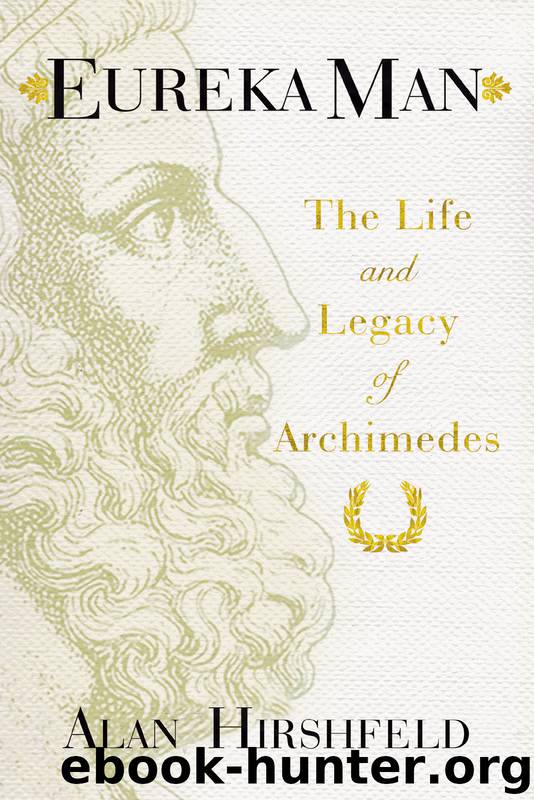Eureka Man by Alan Hirshfeld

Author:Alan Hirshfeld
Language: eng
Format: epub
Publisher: Bloomsbury Publishing Plc
Published: 2009-06-19T04:00:00+00:00
Had there been an ancient equivalent of the 1960s film The Graduate, the word whispered into the young protagonist’s ear would have been papyrus. As a writing medium, papyrus was the “plastics” of its age: lucrative, abundant, and high-tech—well, at least compared to Mesopotamian clay. Egypt held a virtual monopoly on sheets made from the papyrus reed—the plant didn’t grow anywhere else—and exported it throughout the Mediterranean from the third millennium B.C. onward. Papyrus was costly and fragile. Yet for lengthy documents, there was no practical alternative at the time; all that scribal ink had to flow somewhere. When ancient mathematicians read Archimedes, they were most likely reading from papyrus.
The papyrus plant was once ubiquitous in marshes along the Nile. (With the advent of wood-pulp paper, papyrus was no longer cultivated; a modest stand was reintroduced near Cairo in 1969.) To preserve its Mediterranean-wide monopoly, Egypt kept the papyrus-making process secret. Our best guess—confirmed by modern experiment—is that the plant’s stalks were cut into narrow strips, which were overlaid along their edges. A second layer was arranged crosswise, and the combination was pressed, dried, and rubbed smooth until it cohered into a single sheet. Since papyrus is brittle and cannot be creased or folded, individual sheets were glued with starch paste into long scrolls.
The ends of each scroll were affixed to sticks or bars, which were turned together to advance through the document. Scribes typically wrote in a series of columns, several of which could be viewed at a time. Only the inner side of the scroll was used; writing on the backside would have been scuffed away with repeated unfurling and furling of the scroll. There was typically no title page in an ancient scroll; the narrative literally unwound from the very beginning. The colophon, if present, containing essential information about the text—author, title, date, occasionally the scribe’s name—typically appeared at the end of the scroll. Apparently, having read the text, the reader merely left the scroll for the next reader, who opened it up to the identifying colophon.
Pity the poor scholar who wished to locate a passage buried somewhere within a scroll. There was no index, nor even the possibility of an index, to assist in finding the selection. The reader had no alternative but to unfurl the scroll and scan the columns. As the Alexandrian poet and librarian Callimachus grumbled in the third century B.C., “A big roll is a big nuisance.” To allay the problem, Callimachus literally cut up epic works, such as the 150-foot-long Odyssey or the Histories of Herodotus, into separate scrolls, or “books.”
Scribes wrote on papyrus with a reed brush-pen, about eight inches long, one end either crushed or slant-cut, depending on the particular application. Black ink was created by mixing water with a dark powder, such as soot, crushed charcoal, or lampblack, a byproduct of heating carbon-rich oils. Red ink, which was commonly used for titles and initial letters, was pigmented with cinnabar, a crystal ore of mercury, or minium, a lead compound.
Download
This site does not store any files on its server. We only index and link to content provided by other sites. Please contact the content providers to delete copyright contents if any and email us, we'll remove relevant links or contents immediately.
Enlightenment Now: The Case for Reason, Science, Humanism, and Progress by Steven Pinker(7228)
A Journey Through Charms and Defence Against the Dark Arts (Harry Potter: A Journey Through…) by Pottermore Publishing(4781)
The Immortal Life of Henrietta Lacks by Rebecca Skloot(4525)
A Journey Through Divination and Astronomy by Publishing Pottermore(4344)
Elon Musk by Ashlee Vance(4028)
Origin Story: A Big History of Everything by David Christian(3648)
COSMOS by Carl Sagan(3554)
Alchemy and Alchemists by C. J. S. Thompson(3449)
Bad Pharma by Ben Goldacre(3355)
Enlightenment Now by Steven Pinker(3335)
Shadow of Night by Deborah Harkness(3302)
Inferior by Angela Saini(3276)
A Mind For Numbers: How to Excel at Math and Science (Even If You Flunked Algebra) by Barbara Oakley(3217)
Origin Story by David Christian(3147)
The Code Book by Simon Singh(3074)
Signature in the Cell: DNA and the Evidence for Intelligent Design by Stephen C. Meyer(3071)
The Elements by Theodore Gray(2998)
A Brief History of Time by Stephen Hawking(2960)
A Journey Through Potions and Herbology (A Journey Through…) by Pottermore Publishing(2826)
